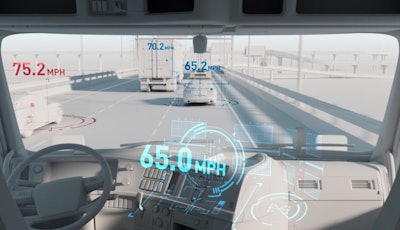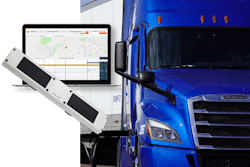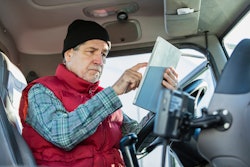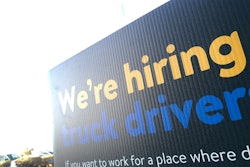
According to the Department of Transportation’s latest Significant Rulemaking Report, the Federal Motor Carrier Safety Administration (FMCSA) will pursue several rulemaking proposals in 2023, including speed limiters, which also landed in the top 10 of the American Transportation Research Institute’s (ATRI) 18th annual Top Industry Issues report this year for the first time.
Schuster Trucking Co. recently installed an intelligent speed assistance (ISA) technology on nearly all of its 460-unit fleet that has helped improve the Le Mars, Iowa-based company’s CSA scores and lower traffic violations. As of July 6, all vehicles in Europe are required to be equipped with ISA technology and while not a prevalent (or mandated) in the U.S., ISA has emerged as a solution to a potential speed limiter mandate while also offering fleets and drivers speed flexibility.
The company’s biggest problem area was in 55-mile-per-hour zones, but now that the company has implemented the E-SMART speed limiter, drivers are automatically slowed to 3 miles per hour over the speed limit in any given area.
“Our 6 to 10 (MPH) and above speeding tickets have dropped drastically. We allow the driver to go three miles an hour over the posted speed limit, and then on interstates that have 70-mile-per-hour or higher speed limits, we allow our drivers to do 72,” said Schuster Director of Safety Chad Hogrefe. “We are under the threshold in all (CSA) categories now, and we were above the threshold prior to E-SMART in unsafe, which is where your speeding tickets would be.”
The E-SMART speed limiter uses proprietary advanced position systems technology within a GPS embedded into its onboard device to accurately locate vehicles and actively manage the maximum allowed speed. Its customers can customize allowances for over the posted speed limit, and the limiter bases that around the speed limit on the road the unit is currently traveling. E-SMART gathers speed-limit data for U.S. roads across multiple databases, including location platform company HERE Technologies, Google and Microsoft and USDOT and state transportation departments.
Hogrefe said he expects speed limiters to soon become regulation and wants to stay ahead of the curve.
Schuster previously limited its trucks at 68 MPH across the board with no way to change that setting for city streets versus interstate speeds, resulting in speeding violations mainly when drivers would max out at 68 in a 55-MPH zone, Hogrefe said. He said drivers can still get tickets when, for example, a truck is going downhill or changing speed zones. That’s because the E-SMART system has no interface with the brake pedal, limiting speeds using the acceleration position sensor.
Because of that, Wes Bement said Arnold Transportation Services, of Grand Prairie, Texas, still accumulates some violations.
“What we found was the violations went from greater violations – higher numbers over the speed limit – to 90% of the violations being within 0 to 5 miles per hour over the speed limit,” said Bement, who serves as risk manager at Arnold. “There are no speeding tickets issued really, but beyond that, I don't know that (E-SMART) directly affects CSA scores. It could potentially affect your accident rating. Arnold has significantly decreased our number of incidents this year, which is good. Can that be directly attributed to E-SMART? I'm sure part of it can.”
Denver-based long-haul transporter Navajo Express (CCJ Top 250, No. 114) said its CSA score has dropped to 38 from 67, and its accident ratio has dropped from 52% to 26% since it began using E-SMART in August 2021.
Daniel Patterson, director of safety at Western Express (No. 37), said his Nashville-based company installed E-SMART on all 3,500 trucks, and it has since seen about a 50% reduction in speeding year-over-year between 2019 and 2020. While some of that can be attributed to COVID-19 because enforcement wasn’t as strict, he said the company has consistently seen an improvement in the overall number of violations.
“This year versus last year, we're currently tracking at about a 22% improvement for speeding violations year-over-year when we factor in miles as well,” he said.
Speeding is a primary factor in accidents, but low bridges also contribute to that number. Patterson said Western Express has also seen a reduction in accidents as a result of less speeding and E-SMART’s low clearance feature.
E-SMART aggregates low-bridge data from state and national databases, including those used by the RV industry. Using that data, it geofences those bridges and decelerates a truck until it is safely stopped before it reaches a low bridge to prevent accidents.
“We operate very heavily in the Northeast, especially in New York where there’s a lot of little bridges and things like that,” Patterson said. “We were able to reduce those types of accidents and almost eliminate those. If we have one now, it's a very low-cost incident, or there's no damage at all, so that's definitely a big (saver) just on the asset side.”
New York City Mayor Eric Adams and NYC Department of Citywide Administrative Services Commissioner Dawn Pinnock in August announced an ISA pilot initiative for 50 city fleet vehicles from nine agencies using the SafeSpeed system from MAGTEC.
In addition to speed and hazards like low bridges, the E-SMART system has another asset protection feature. The immobilization feature allows companies to prevent the truck from moving for something as simple as a driver hasn’t turned in their paperwork to something as drastic as the truck being stolen. The system also provides real-time safety alerts on drivers’ in-cab mobile devices via app.
Patterson said Western Express uses the verbal alerts to remind drivers of their speed when going down a hill.
Bement said the E-SMART system helps the safety department enhance its in-cab coaching abilities by allowing them to focus on areas outside of speeding, which ultimately helps reduce turnover. Because many trucking companies have policies regarding a maximum number of speeding violations or accidents before a driver is terminated, the E-SMART system also helps with retention on that end.
Prior to integrating the E-SMART system, Arnold had trucks set at a max speed of 68 MPH across the board. He said this system is more satisfactory for drivers because the company was able to bump that speed to a maximum of 70 MPH for interstates.
Hogrefe said that’s a big deal for Schuster’s drivers.
“I think it has helped our retention with drivers in that they can run faster on the interstates, and that seems like that makes up for being governed in the 45-, 55-, 65-mile-an-hour zones,” he said.
But Patterson said, though helpful, a speed limiter – like driver-facing cameras – will always get pushback from some drivers.
“You're going to have a portion of drivers that don't want a speed limiter at all. There are going to be those owner operators and those companies that just don't want to have anything to do with them,” he said. “But I think that you're going to see larger companies especially adopt this type of speed limiter.”













